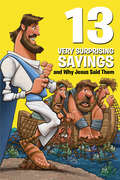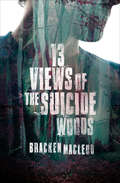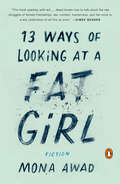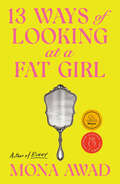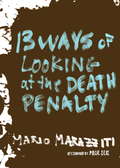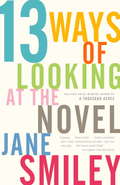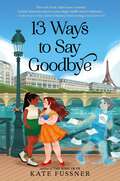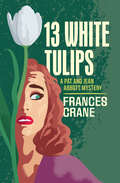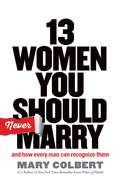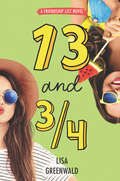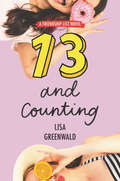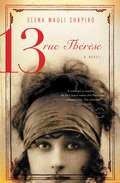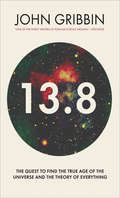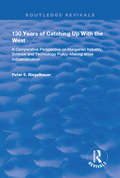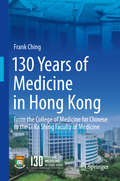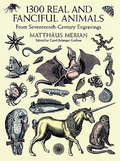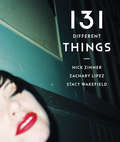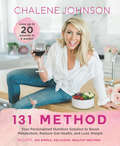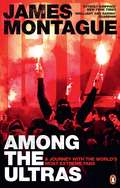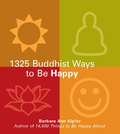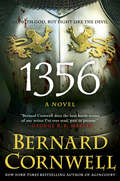- Table View
- List View
13 Very Surprising Sayings and Why Jesus Said Them (13 Very)
by Mikal KeeferIf you want kids to do God’s Word and not just hear it—you’re in exactly the right place. Each session focuses on one key Bible truth—kids will discover it, think about it, talk about it, pray about it, and apply what they learn. You’ll drive that point home through Bible exploration, fun discussions, giggle-worthy games, and oh-wow activities that engage kids in multiple ways. Just add an adult or teenage leader to these easy-to-lead sessions to keep kids engaged, entertained, and growing in their faith! Each session isFlexible—sessions work for 1 or 2 kids, 12 kids, or moreMulti–aged—suitable for all elementary kidsLow–prep—using easy-to-find supplies45 minutes of fun—with time stretchers to fill an hourRelational—children grow close to Jesus and each otherPerfect for any children’s ministry program—Sunday school, children’s church, and more! Help kids discover the faith-building, life-changing truths tucked into 13 of Jesus’ surprising sayings. They will begin to understand what it means to start fishing for people, love the meanies they know, why they would want to be last, and others. And along the way, kids will see that Jesus changes everything—for those who choose to follow Him.
13 Views of the Suicide Woods
by Bracken MacLeod“Dark, human stories of horror and modern noir [by] one of the brightest stars of the next generation.” —Christopher Golden, New York Times–bestselling author of Ararat A young woman waits for her father, who has gone to a place from which no one intends to return. A single word is the push that may break a man and save a life. The members of a winemaking community celebrate the old time religion found flowing in the blood of the vine. A desperate man seeking a miracle cure gets more than a peek behind the curtain of Dr. Morningstar’s Psychic Surgery. The author of Stranded “brings together the macabre and the offbeat” (Publishers Weekly) in this remarkable collection of stories that inhabit the dark places where pain and resignation intersect, in which the fear of a quiet moment alone is as terrifying as the unseen thing watching from behind the tree line. “[A] superb new collection . . . There are pieces here that nod to distinguished ancestors like Ambrose Bierce’s ‘An Occurrence at Owl Creek Bridge,’ Flannery O’Connor’s ‘A Good Man Is Hard to Find’ and Shirley Jackson’s ‘The Lottery’.” —The New York Times
13 Ways of Looking at a Fat Girl: A Novel
by Mona Awad<P> Growing up in the suburban hell of Misery Saga (a.k.a. Mississauga), Lizzie has never liked the way she looks--even though her best friend Mel says she's the pretty one. She starts dating guys online, but she's afraid to send pictures, even when her skinny friend China does her makeup: she knows no one would want her if they could really see her. So she starts to lose. <P>With punishing drive, she counts almonds consumed, miles logged, pounds dropped. She fights her way into coveted dresses. She grows up and gets thin, navigating double-edged validation from her mother, her friends, her husband, her reflection in the mirror. But no matter how much she loses, will she ever see herself as anything other than a fat girl? <P>In her brilliant, hilarious, and at times shocking debut, Mona Awad simultaneously skewers the body image-obsessed culture that tells women they have no value outside their physical appearance, and delivers a tender and moving depiction of a lovably difficult young woman whose life is hijacked by her struggle to conform. <P>As caustically funny as it is heartbreaking, 13 Ways of Looking at a Fat Girl introduces a vital new voice in fiction.
13 Ways of Looking at a Fat Girl: From the author of the TikTok phenomenon BUNNY
by Mona AwadWinner of the Amazon First Novel AwardWinner of the Colorado Book Award for Literary FictionShortlisted for the Scotiabank Giller PrizeLonglisted for the 2017 Stephen Leacock Memorial Medal for HumourLonglisted for the 2018 International IMPAC Dublin Literary AwardGrowing up in the suburban hell of Misery Saga (a.k.a. Mississauga), Lizzie has never liked the way she looks—even though her best friend Mel says she&’s the pretty one. She starts dating guys online, but she&’s afraid to send pictures, even when her skinny friend China does her makeup: she knows no one would want her if they could really see her. So she starts to lose. With punishing drive, she counts almonds consumed, miles logged, pounds dropped. She fights her way into coveted dresses. She grows up and gets thin, navigating double-edged validation from her mother, her friends, her husband, her reflection in the mirror. But no matter how much she loses, will she ever see herself as anything other than a fat girl? In her brilliant, hilarious, and at times shocking debut, Mona Awad simultaneously skewers the body image-obsessed culture that tells women they have no value outside their physical appearance, and delivers a tender and moving depiction of a lovably difficult young woman whose life is hijacked by her struggle to conform. As caustically funny as it is heartbreaking, 13 Ways of Looking at a Fat Girl introduces a vital new voice in fiction.
13 Ways of Looking at the Death Penalty
by Paul Elie Mario MarazzitiNation states and communities throughout the world have reached certain decisions about capital punishment: It is the destruction of human life. It is ineffective as a deterrent for crime. It is an instrument the state uses to contain or eliminate its political adversaries. It is a tool of "justice" that disproportionality affects religious, social, and racial minorities. It is a sanction that cannot be fixed if unjustly applied. Yet the United States--along with countries notorious for human rights abuse--remains an advocate for the death penalty. In these thirteen pieces, Mario Marazziti exposes the profound inhumanity and irrationality of the death penalty in this country, and urges us to join virtually every other industrialized democracy in rendering capital punishment an abandoned practice belonging to a crueler time in human history. A polemical book, yes, yet one that brings together a wide range of stories to compel the heart as well the mind.From the Hardcover edition.
13 Ways of Looking at the Novel
by Jane SmileyPulitzer Prize winner and bestselling novelist Jane Smiley celebrates the novel--and takes us on an exhilarating tour through one hundred of them--in this seductive and immensely rewarding literary tribute. In her inimitable style-exuberant, candid, opinionated-Smiley explores the power of the novel, looking at its history and variety, its cultural impact, and just how it works its magic. She invites us behind the scenes of novel-writing, sharing her own habits and spilling the secrets of her craft. And she offers priceless advice to aspiring authors. As she works her way through one hundred novels--from classics such as the thousand-year-old Tale of Genji to recent fiction by Zadie Smith and Alice Munro--she infects us anew with the passion for reading that is the governing spirit of this gift to book lovers everywhere.
13 Ways to Eat a Fly
by Sue HeavenrichThirteen flies become tasty snacks in this clever reverse counting book about subtraction, predators, and prey.Science meets subtraction in this fresh and funny STEM picture book with plenty of ewww factor to please young readers. A swarm of thirteen flies buzzes along, losing one member to each predator along the way. Whether the unfortunate insects are zapped or wrapped, liquefied or zombified, the science is real--and hilariously gross. Includes a guide to eating bugs, complete with nutritional information for a single serving of flies.
13 Ways to Say Goodbye
by Kate FussnerA novel-in-verse about life after loss, 13 Ways to Say Goodbye beautifully renders the power of sibling bonds, the depth of grief, and the strength of learning to love again, perfect for fans of Everywhere Blue and The Distance to Home, from the author of The Song of Us.Nina always followed her older sister, Lily. But just before her thirteenth birthday, Lily died, leaving Nina behind forever.In the three years since she lost her sister, Nina has completed Lily’s secret Before Birthday lists to continue in her footsteps. But now Nina is catching up. When Nina flies to Paris, France, and completes tasks that Lily never finished, Nina finds herself magically transported inside of her own memories, face-to-face with the ghosts of her past.With her birthday looming and the last list running out, Nina is torn between visiting her sister in her memories and adventuring in the present, including crushing hard on her art classmate, Sylvie. Should she follow Lily’s instructions or try something new? And what happens when she finishes the list?
13 White Tulips (The Pat and Jean Abbott Mysteries Series)
by Frances Crane<p>A young couple and their dachshund star in a stylish San Francisco–set Golden Age mystery of “high ingenuity” (The New York Times).<p> <p>Jack Ivers, a man-about-town with a taste for rich women, has been found dead in his bed. What’s particularly odd is that the chief suspect, a surgeon’s fashionable wife, claims that she spotted thirteen red tulips upon entering the victim’s home—that were somehow replaced with thirteen white tulips by the time she departed.<p> <p>It’s up to sleuthing spouses Jean and Pat Abbott to dig through the dead man’s questionable past and determine in whose heart a murderous passion blossomed . . .<p>
13 Women You Should Never Marry: And How Every Man Can Recognize Them
by Mary Colbert"He who finds a wife finds a good thing" does not mean every woman qualifies as a good wife.
13 and 3/4 (Friendship List #4)
by Lisa GreenwaldBFFs Ari and Kaylan make a new bucket list as they set out for different summer camps in the fourth and final Friendship List novel. The perfect summer read for fans of Lauren Myracle and Rachel Renee Russo’s Dork Diaries! Ari and Kaylan aren’t sure how they’re going to survive their first summer apart. No pool. No sleepovers. No emergency late night chats on the porch.So as Ari returns to Camp Silver and Kaylan heads off to comedy camp, they come up with a new list of 13 and 3/4 ways to keep their friendship strong as they tackle everything from bias to batik and moping to matchmaking. Told in alternating perspectives, the fourth book in the popular Friendship List series is sure to make readers cry, laugh, and start plotting their own friendship lists.
13 and Counting: 11 Before 12, 12 Before 13, 13 And Counting (Friendship List #3)
by Lisa GreenwaldFans of Lauren Myracle and Rachel Renee Russo's Dork Diaries will adore the third book in this laugh-out-loud series about two BFFs who master middle school with a list of thirteen goals they MUST achieve before their first summer apart.With winter break almost over and seventh grade spinning beyond their control, best friends Kaylan and Ari write a new list of 13 resolutions to make the New Year, middle school, and their friendship even more amazing before they go to separate camps next summer.But what happens when their bestie bucket list reveals issues in their friend group? Can they want totally different things and still be BFFs?Told in the alternating POVs of Ari and Kaylan—and with goals inspired by suggestions from readers—this contemporary coming-of-age story is bound to be the most heartbreaking and hilarious Friendship List yet.
13 for Luck
by Agatha Christie13 of Agatha Christie's short stories, featuring Hercule Poirot, Miss Marple, Mr. Parker Pyne, and others.
13, rue Thérèse: A Novel
by Elena Mauli ShapiroAmerican academic Trevor Stratton discovers a box full of artifacts from World War I as he settles into his new office in Paris. The pictures, letters, and objects in the box relate to the life of Louise Brunet, a feisty, charming Frenchwoman who lived through both World Wars. As Trevor examines and documents the relics the box offers up, he begins to imagine the story of Louise Brunet's life: her love for a cousin who died in the war, her marriage to a man who works for her father, and her attraction to a neighbor in her building at 13 rue Thérèse. The more time he spends with the objects though, the truer his imaginings of Louise's life become, and the more he notices another alluring Frenchwoman: Josianne, his clerk, who planted the box in his office in the first place, and with whom he finds he is falling in love.
13.8: The Quest to Find the True Age of the Universe and the Theory of Everything
by John GribbinThe bestselling author of The Scientists presents &“alively and accessible look at how astronomers determined the age of our universe&” (Publishers Weekly, starred review). The twentieth century gave us two great theories of physics. The general theory of relativity describes the behavior of very large things, and quantum theory the behavior of very small things. In this landmark book, John Gribbin—one of the best-known science writers of the past thirty years—presents his own version of the Holy Grail of physics, the search that has been going on for decades to find a unified &“Theory of Everything&” that combines these ideas into one mathematical package, a single equation that could be printed on a T-shirt, containing the answer to life, the Universe, and everything. With his inimitable mixture of science, history, and biography, Gribbin shows how—despite skepticism among many physicists—these two great theories are very compatible, and point to a deep truth about the nature of our existence. The answer lies, intriguingly, with the age of the universe: 13.8 billion years. &“Gribbin is a confident, engaging guide . . . a lovingly rendered history.&”—The Wall Street Journal &“An exciting chronicle of a monumental scientific accomplishment by a scientist who participated in the measuring of the age of the universe.&”—Kirkus Reviews &“A book that hits readers with unrelenting detail. And with a story as grand as this one, that&’s exactly the way a good science book should have it. Nothing will be lost here, and everything—a clear understanding—will be gained.&”—Astronomy &“A welcome and relatively quick read for cosmology buffs, students, and amateur astronomers.&”—Booklist
130 Years of Catching Up with the West: A Comparative Perspective on Hungarian Science and Technology Policy-making Since Industrialization (Routledge Revivals)
by Peter S BiegelbauerThis title was first published in 2000: Issues such as globalization and the fight against joblessness as well as the growth dynamics of economies in general have been linked with science and technology. Accordingly, the growing public interest in the effects of science and technology on society and politics and vice versa have been the foremost reason for the creation of this study. One of the central questions for politicians as well as for scholars in the field of science and technology is, "How can I influence a given science and technology system in a way so as to achieve optimal outcomes for a given national economy?". The study at hand tries to answer this question by analyzing the Hungarian research sphere from industrialization until the late-20th century. Since the beginning of industrialization, Hungary has made a number of attempts to catch up with the economically more developed Western European countries. The problems encountered in the course of the Hungarian efforts are surprisingly similar to the difficulties that modern, fully industrialized economies are facing today.
130 Years of Medicine in Hong Kong: From The College Of Medicine To The Li Ka Shing Faculty Of Medicine
by Frank ChingThis book reviews the medical history of Hong Kong, beginning with its birth as a British colony. It introduces the origins of Hong Kong’s medical education, which began in 1887 when the London Missionary Society set up the Hong Kong College of Medicine for Chinese. When the University of Hong Kong was established in 1911, the College became its medical faculty. The faculty has gained distinction over the years for innovative surgical techniques, for discovering the SARS virus and for its contribution to advances in medical and health sciences. This book is meant for general readers as well as medical practitioners. It is a work for anyone interested in Hong Kong or in medical education.
1300 Real and Fanciful Animals: From Seventeenth-Century Engravings
by Matthäus The MerianA painter whose father was an engraver and publisher of the same name, Matthäus Merian (1621-1687) published this remarkable group of unusual and highly imaginative animal illustrations. This copyright-free collection includes a large and fascinating selection of engravings that illustrate scientific specimens and legendary creatures - all meticulously reproduced from an extremely rare eighteenth-century edition.Carefully arranged into six major divisions (quadrupeds, snakes, mollusks and crustaceans, fish, birds, and insects), approximately 1,300 copyright-free images include realistic and fanciful portrayals of a varied array of real animals, in addition to such imaginary creatures as unicorns, dragons, basilisks, harpies, griffins, and other mythical beasts. Identifying captions in Latin accompany many of the illustrations. Commercial artists, illustrators, and craftspeople will find a host of uses for these lovingly detailed engravings: as book and magazine illustrations and as attention-getting graphics ideal for enhancing flyers, brochures, newsletters, and any number of other print projects. Art lovers and antiquarians - anyone with an interest in the art and ideas of an earlier era - will enjoy browsing through these wonderful antique images.
131 Different Things
by Zachary Lipez&“Framed by Zinner&’s sly photograpy . . . A boozy, grungy, alt-rock fable&” from the collaborators of Please Take Me Off the Guest List (Kirkus Reviews). When Sam, a bartender in New York, hears that his ex, Vicki, his one true love, has quit AA and is out drinking again, he embarks on a quest to find her. Sam and his sidekick Francis trek from dive bars to gay bars to rocker bars—encountering skinheads, party promoters, underage drug dealers, and dominatrixes—but they are always one step behind Vicki. It begins to seem like 131 different things are keeping the lovers apart. Before the night is over, Sam will have to wrestle with what he is really looking for. Nick Zinner—who plays guitar in the three-time Grammy-nominated band Yeah Yeah Yeahs—provides the visual framework for this inventive novella with his intimate photography. Known for his essays and music writing for Noisey, Vice, and Penthouse, Zachary Lipez brings his pithy, multilayered, and self-deprecating voice to this debut work of fiction. The prose and photography are tied together in a playful taxonomic scheme by editor and art director Stacy Wakefield, the author of the novel The Sunshine Crust Baking Factory. &“Engaging . . . may conjure your worst, most desperate drunken memories of your 20s-30s, but in a good way! The story is illustrated with Nick Zinner&’s beautiful photos. This is a must read for all music/nightlife loving New Yorkers, or folks who wished they lived here in the aughts.&”—BUST, Holiday Gift Guide &“An entertaining pub-crawl saga like no other.&”—The Berkshire Eagle
131 Method: Your Personalized Nutrition Solution to Boost Metabolism, Restore Gut Health, and Lose Weight
by Chalene JohnsonChalene Johnson, New York Times best-selling author and award-winning entrepreneur who's built and sold several multimillion-dollar lifestyle companies, offers a revolutionary fitness program with proven success based on her successful online program of the same name.Diets are dumb. You aren't.Your personalized plan for gut health, wellness, and weight lossYou're smart. You're sick of gimmicks and trendy diets that leave you with frustration and a slower metabolism. The 131 Method gets to the root of the problem--gut health--and delivers a personalized solution to wellness, hormone balance, and permanent weight loss based on the Nobel Prize-winning science of autophagy and diet phasing. Finally, a science-based solution that's actually doable!Following her own health scare, health and wellness expert Chalene Johnson set out to understand the science and individuality of metabolism. Working with renowned researchers, doctors, and registered dietitians, she developed a simplified 3-phase plan for health promoting weight loss. This proven methodology was tested with more than 25,000 individuals. Now she distills the essentials of her hugely successful online program into the 131 Method book.1 Objective (set by you!), 3 Weeks of Diet Phasing, and 1 Week to Fast and Refuel. 131 Method guides you through Chalene's three-phase, 12-week solution, helping you personalize every step of the way. You'll: * Lose weight without slowing your metabolism * Improve gut health and boost immunity * Fix cravings and reset hormones * Discover 100 delicious, easy recipesThe 131 Method isn't a one size fits all diet, it's how to eat a diet that works! You'll get everything you need to change your thinking, transform your body, and improve your life . . . for good!
1312: A journey with the world’s most extreme fans
by James MontagueYou can see them, but you don't know them.Ultras are football fans like no others. A hugely visible and controversial part of the global game, their credo and aesthetic replicated in almost every league everywhere on earth, a global movement of extreme fandom and politics is also one of the largest youth movements in the world. Yet they remain unknown: an anti-establishment force that is transforming both football and politics. In this book, James Montague goes underground to uncover the true face of this dissident force for the first time. 1312: Among the Ultras tells the story of how the movement began and how it grew to become the global phenomenon that now dominates the stadiums from the Balkans and Buenos Aires. With unprecedented insider access, the book investigates how ultras have grown into a fiercely political movement, embracing extremes on both the left and right; fighting against the commercialisation of football and society – and against the attempts to control them by the authorities, who both covet and fear their power.
132 Career Tips for Women
by Melody R Green<p>If it's been a while since you looked for a new job the chances are the job market has changed while you've been employed. <p>To keep ahead of the rest it's wise to have the best tips for the process at your finger tips and <i>132 Career Tips for Women<i> e-book gives you these. <p>No matter if you are a first time job hunter, looking to change industry sectors, re-entering the workforce, consolidating your career or enhancing your direction <i>132 Career Tips for Women</i> has been written with you in mind. <p>The better you understand what motivates a boss when hiring staff, or know the tips that help you engage better with time poor recruiters, the easier your job process will be. This knowledge will build your self-confidence by allowing you to appreciate what you have to offer a prospective employer. <p>Filled with practical tips and strategies let <i>132 Career Tips</i> for Women help you make your next career move and see the difference.</p>
1325 Buddhist Ways to Be Happy
by Barbara Ann KipferHAPPY ENDINGS ARE NOT RELIABLE. HAPPY NOWS ARE.The attainment of happiness has always been at the heart of Buddha's teachings. The Buddha himself was known as "The Happy One."1325 Buddhist Ways to Be Happy draws on the rich heritage of Buddhism for quick ideas, thoughts and teachings that will guide you to a deeper, more fulfilling happiness in your daily life. You don't need to be a Buddhist to understand and benefit from the wisdom in this book. Open to any page and discover a new path to happiness.
1356
by Bernard Cornwell"The most prolific and successful historical novelist in the world today" (Wall Street Journal) has delivered another blockbuster with this thrilling tale of peril and conquest at the Battle of Poitiers.September 1356. All over France, towns are closing their gates. Crops are burning, and through-out the countryside people are on the alert for danger. The English army--led by the heir to the throne, the Black Prince--is set to invade, while the French, along with their Scottish allies, are ready to hunt them down.But what if there was a weapon that could decide the outcome of the imminent war?Thomas of Hookton, known as le Batard, has orders to uncover the lost sword of Saint Peter, a blade with mystical powers said to grant certain victory to whoever possesses her. The French seek the weapon, too, and so Thomas's quest will be thwarted at every turn by battle and betrayal, by promises made and oaths broken. As the outnumbered English army becomes trapped near Poitiers, Thomas, his troop of archers and men-at-arms, his enemies, and the fate of the sword converge in a maelstrom of violence, action, and heroism.Rich with colorful characters, great adventure, and thrilling conflict, 1356 is a magnificent tale of how the quest for a holy relic with the power to change history may culminate in an epic struggle.
1366 Technologies
by David Kiron Ramana Nanda Joseph B. LassiterJust months after declaring their intent to become a solar cell equipment supplier, van Mierlo and Sachs were again revisiting the issue of what the company should be. Becoming a successful solar cell manufacturer would potentially be much more lucrative than becoming a successful equipment supplier. But, the latter was much less capital intensive and perhaps a less operationally risky approach. For van Mierlo and Sachs, the question - "What kind of company should 1366 become?" - was back on the table.
